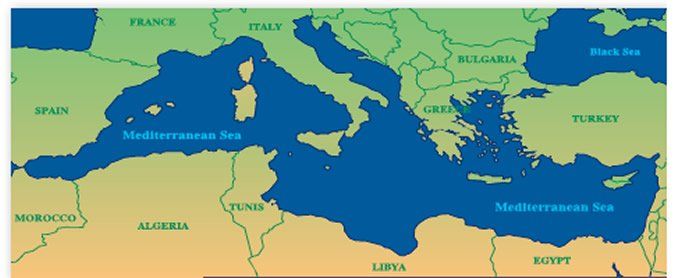This large and diverse region includes 22 countries located within Europe, Africa, and Asia, including Greece, France, Spain, and Italy, but also Turkey, Morocco, Libya, and Egypt. “It is important to recognize that these countries encompass a wide array of cultural and culinary traditions, which means there is no single version of the ‘Mediterranean’ diet,” says Alice Lichtenstein, DSc, a professor at Tufts’ Friedman School of Nutrition Science and Policy and executive editor of Tufts Health & Nutrition Letter. “The good news is, that means a Mediterranean-type dietary pattern can be adapted to many different tastes and preferences.”
Not all traditional dishes from this region are the healthiest choices, but the climate and location support an abundance of seafood and the cultivation of nuts, legumes, grains, vegetables, and fruits (including olives for olive oil and grapes for wine) that pervade the local cuisines.
The Origins: In the 1950s and 1960s nutrition research pioneer Ancel Keys and his colleagues studied the eating patterns and health of populations in seven different countries around the globe. The researchers observed that people living in Crete, parts of Greece, and southern Italy tended to live longer and have lower rates of heart disease and some cancers than other populations in their study. Keys attributed the relative good health and longevity of these populations to the foods they ate, and wrote books promoting the regional (Mediterranean) diet. While the cross-national study (called an “ecologic” study) by Keys and his colleagues was observational and did not prove cause and effect, the results stimulated further research that has established the strong health benefits of traditional Mediterranean-style dietary patterns.
The Research: Among the numerous studies that have confirmed benefits of a Mediterranean-style dietary pattern were some long-term studies in population cohorts. “These studies look at individual people over time, which allows much better adjustment for potentially confounding risk factors than ecologic studies,” says Dariush Mozaffarian, MD, DrPH, dean of the Friedman School and editor-in-chief of Tufts Health & Nutrition Letter. “There were also controlled trials looking at Mediterranean-style diets and risk pathways like blood pressure, cholesterol, and weight, and clinical trials of cardiovascular disease and diabetes endpoints.”
In 2013, results from the PREDIMED trial gave a special boost to the evidence supporting a Mediterranean-style eating pattern. PREDIMED was a controlled trial—the type of study that is designed to prove cause and effect. Nearly 8,000 adults in Spain age 55 years or older who were at high risk for developing heart disease were divided into three groups: The first group was given advice to follow a Mediterranean-style diet plus free extra virgin olive oil (one liter per week); the second group was given advice to follow a Mediterranean-style diet plus free mixed tree nuts (walnuts, hazelnuts, and almonds; one ounce per day); and the third group (the control arm) was given advice to follow a low-fat diet. After five years, each of the Mediterranean diet groups had significantly lower incidence of heart attack, stroke, or death—about 30 percent lower risk—in comparison to the control group. The Mediterranean diet groups also tended to have less weight gain (even though their fat consumption went up, largely from olive oil and nuts) and lower risk of type 2 diabetes. “What we learned from the PREDIMED study is that in Spain, a Mediterranean country, maintaining a traditional dietary pattern is associated with the best health outcomes,” says Lichtenstein. “This does not mean tossing extra nuts or olive oil on your salad will guarantee positive health outcomes. It is important to substitute foods associated with health benefits for less-health-promoting choices: Replacing croutons with nuts or crumbled bacon with olive oil, for example.”
Key Components: For those looking for a single diet “prescription,” the lack of a precise definition on every aspect of a Mediterranean diet can be frustrating. “In the PREDIMED trial, the Mediterranean diet advice focused on increasing intakes of healthy foods like extra virgin olive oil, nuts, fruits, vegetables, legumes, and fish; and limiting red and processed meats, sugary beverages, and refined grains and starches including industrial bakery foods, desserts, potatoes, and sweets,” says Mozaffarian. (See The PREDIMED Study box below.) “Importantly, the Mediterranean diet advice in this trial did not include any targets for fat, carbohydrate, or protein,” says Mozaffarian. “Rather, the advice focused on increasing healthy foods, in particular minimally processed, bioactive-rich foods. This is consistent with modern nutrition evidence that the types of foods we eat are more important than macronutrient contents.”
Making it Work for You: The range of dietary choices in a traditional Mediterranean diet provides a lot of flexibility. “You can fill your plate with a wide variety of your favorite fruits, vegetables, and legumes; snack regularly on nuts; use extra virgin olive oil without fear; enjoy fish and other seafood; and treat yourself with delicious dark chocolate,” saya Mozaffarian. “Minimize industrial, processed foods high in refined grains, starches, and sugars; and limit red and processed meat, cream, butter, and margarine. There is no need to count carbs, fats, protein, or calories. Also, aim to linger over your meals, seated at a table, rather than wolfing down your food.”
THE PREDIMED STUDY
The PREDIMED study, which provided strong support for the health benefits of a Mediterranean-style dietary pattern, advised participants to*:
-Use olive oil abundantly for cooking and dressing dishes
-Consume :
-≥ 2 daily servings of vegetables (at least one as fresh vegetables in a salad)
-≥ 2 to 3 daily servings of fresh fruits (including natural juices)
-≥ 3 weekly servings of legumes
-≥ 3 weekly servings of fish or seafood (at least one as fatty fish)
-≥ 1 weekly serving of nuts or seeds
-Select white meats (like poultry without skin or rabbit) instead of red or processed meats (like burgers or sausage)
-Cook a sauce of tomato, garlic, onion, and olive oil (and herbs as desired) and use it to dress vegetables, pasta, rice and other dishes at least two times a week
-Eat two main meals per day seated at a table, lasting at least 20 minutes each
-Eliminate or limit consumption of cream, butter, margarine, deli meat, pate, duck, carbonated and/or sugared beverages, pastries, industrial bakery products (such as cakes, donuts, cookies), industrial desserts (puddings, custard), French fries or potato chips, out-of-home pre-cooked cakes and sweets
If wine intake was customary, a glass of wine per day with meals was recommended (150 mL for men, 100 mL for women).
No limits were placed on nuts (raw and unsalted), eggs, fish, seafood, low-fat cheese, whole-grains, or dark chocolate (50%+ cocoa).
*These guidelines were designed for a traditional Spanish diet. Some foods and quantities may not be as familiar to Americans.
Try these quick and easy tips for moving your eating pattern closer to a Mediterranean-style diet:
-Include fruits, (fresh, frozen, or canned in juice) several times each day.
-Eat more beans and lentils. These inexpensive, easy to prepare, and versatile options can be tossed into nearly any mixed dish to replace some or all of the meat, sprinkled onto salads, stirred into soups, heated with greens or grains, and pureed into dips and spreads.
-Choose Veggies (raw or cooked; fresh, frozen, or canned) as a key part of every meal. (If you prefer a more typical American breakfast, emphasize fruits rather than veggies in the morning.)
-Increase intake of seafood and meatless meals.
-Expand your intake of whole grains, while reducing refined grain products. Whole grains make great sides, pilafs, and chilled salads.
-Add nuts, fruits, frozen vegetables, canned beans (low-sodium or rinsed), and extra virgin olive oil into prepared foods if you dont cook from scratch.
-Use extra virgin olive oil as your primary fat for cooking and dressing foods.
-Try yogurt the Mediterranean wayunsweetenedand add fruits and/or nuts, or use as a tangy base for dips and sauces to pair with other foods.
-Replace refined grain snacks such as pretzels, chips, and refined crackers with choices such as nuts, fruits, and whole-grain crackers.





















Thank s 4 the Tip!!!
Your geographical description of the “Mediterranean diet” area is strange – and NOT particularly valid:
A more accurate description would include Portugal, Andulasia region of Spain, south France, south Italy & Sicily, Albania, south Greece & Crete, Cyprus, parts of Turkey, Georgia, Armenia, and other Caucaus regions, Syria, Lebanon, Israel, Egypt, Tunisia, and Morocco.
Certainly NOT northern France or northern Italy. And “Libya”? what exactly is “Libyan” cuisine or diet?
I’m not sure where you’re getting your info, however good
topic. I must spend a while studying much more or figuring out more.
Thanks for great info I was on the lookout for this information for my
mission.